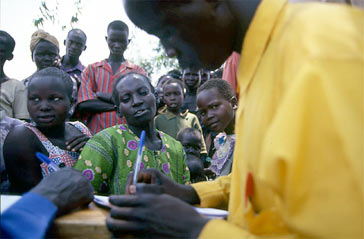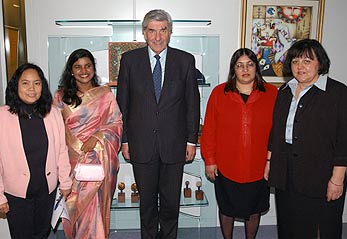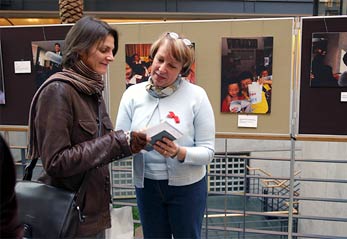Afghanistan: High Commissioner Ruud Lubbers returns from 5-day mission to Pakistan and Iran
Afghanistan: High Commissioner Ruud Lubbers returns from 5-day mission to Pakistan and Iran
High Commissioner Ruud Lubbers returned yesterday from a five-day mission to Pakistan and Iran, where he reviewed UNHCR preparations for a possible influx from Afghanistan and held talks with senior government officials.
Mr. Lubbers said he emphasized in his meetings with officials in both countries that the first priority of the UN family must be the provision of urgently needed humanitarian assistance inside Afghanistan. The question is; of course, can it be delivered in the right quantities to the right places at the right time? Security allowing, UNHCR intends to make use of its existing network of local staff and more than 100 local NGO partners in Afghanistan to continue and expand its so-called quick impact projects and other forms of support and assistance for returnees, displaced persons and other affected populations.
The closed-border policies of both Pakistan and Iran remain in effect. The High Commissioner told the leaders of both countries that he understands they have a responsibility for the security of their state and the well-being of their people. At the same time, as the international agency given a mandate for the protection of refugees, UNHCR has its own responsibilities and continues to urge that borders be open to all of those in need of protection and assistance.
So, in Mr. Lubbers' words, while we agree to disagree on the fundamental question of open borders, we will also try to work together with Afghanistan's neighbouring states to try to ensure that those most vulnerable can receive temporary protection and assistance. This means, for example, that women, children, elderly, the sick and wounded would be cared for in Pakistan in the sites we have already identified with Pakistan authorities. About 15 of those sites, with a capacity of about 150,000 could start operations now and we are working on a capacity for another 150,000 in Pakistan in this first phase of the UNHCR response. We are ready to begin transferring some of the 2,400 vulnerable people at the Killi Faizo staging area near the Chaman border crossing to one of the nearby camps as soon as possible.
Discussions were also held on the use of the new UNHCR camps for the transfer of Afghans who recently arrived at the makeshift Jalozai site near Peshawar. We are also working on arrangements with the government for some of the tens of thousands of recent "illegal" arrivals - people who have entered Pakistan through back routes because official crossing points are closed - to be authorized to make their way to the new camps without fear of deportation. Many of these people are in need of support and assistance but are afraid to come out of the shadows for fear of being sent back to Afghanistan.
There are no firm statistics on the total number of these new arrivals from Afghanistan to Pakistan in the aftermath of Sept. 11 but we are beginning to get a somewhat clearer picture and now estimate the number is more than 100,000. We hope to come up with a reasonably scientific figure for the whole of Pakistan in the next few days. One of the problems in compiling an estimate is that, by one count, there are as many as 300 crossing points from Afghanistan into Pakistan, including numerous mountain footpaths. And for as long as new arrivals are not channelled into camps, this makes estimating the total number of new arrivals exceptionally difficult.
What we do know is the following. In North-West Frontier Province, a detailed and systematic survey carried out by UNHCR in Peshawar and in the old refugee camps in NWFP from 17-25 October revealed that around 65,000 new arrivals had come from Afghanistan since 11 September. Over the past week, an average of around 2,500 Afghans are known to have crossed the border by a variety of different crossing points. Then on Wednesday, the number jumped to just under 5,000 for the day. I don't have yesterday's figure yet. But it is not quite clear at this point how many of these arrivals could be considered people fleeing because of fears of war, persecution, conscription, drought or other compelling humanitarian reasons, and how many are traders, smugglers or others engaged in more routine cross-border business. In neighbouring Baluchistan Province to the south of NWFP, no overall estimate is currently available for the number of new arrivals, or indeed of those Afghans who may have entered the country and gone further afield to Karachi and other more distant towns and cities. However, judging from the limited data that has so far been available from the main Chaman crossing in Baluchistan, this would certainly be in the tens of thousands.
Yesterday, no new arrivals were permitted to enter the Killi Faizo staging camp near Quetta, in the southern Pakistan province of Baluchistan, so the number in the camp remains at around 2,400. We hope to start transferring these people to camps nearby, possibly as early as today, so there will be room at the staging site for more vulnerables who may be on the way. UNHCR staff at the border yesterday could see around 20 families waiting on the far side of the border, but by the end of the day none appeared to have been permitted to enter. An unknown number of Afghans are believed to be further back in the Spin Boldak area, either in a Taliban-controlled camp or in the town. It seems to have been getting increasingly difficult for them to get near the border, let alone cross it. However, the local authorities maintain that the policy of allowing vulnerable people to enter and receive assistance remains the same.
UNHCR has been receiving generous support from donors who have now provided $56.5 million US dollars to the Afghanistan emergency to date - a sufficient amount to enable UNHCR to handle the first 400,000 refugees from Afghanistan to Iran, Pakistan and the Central Asian republics. Most of the funds have been donated by governments, but $4.5 million came from individual donors in a number of countries. The largest private donor amount - $1.5 million - was raised by individuals in Italy, followed by private donors in the United States.





